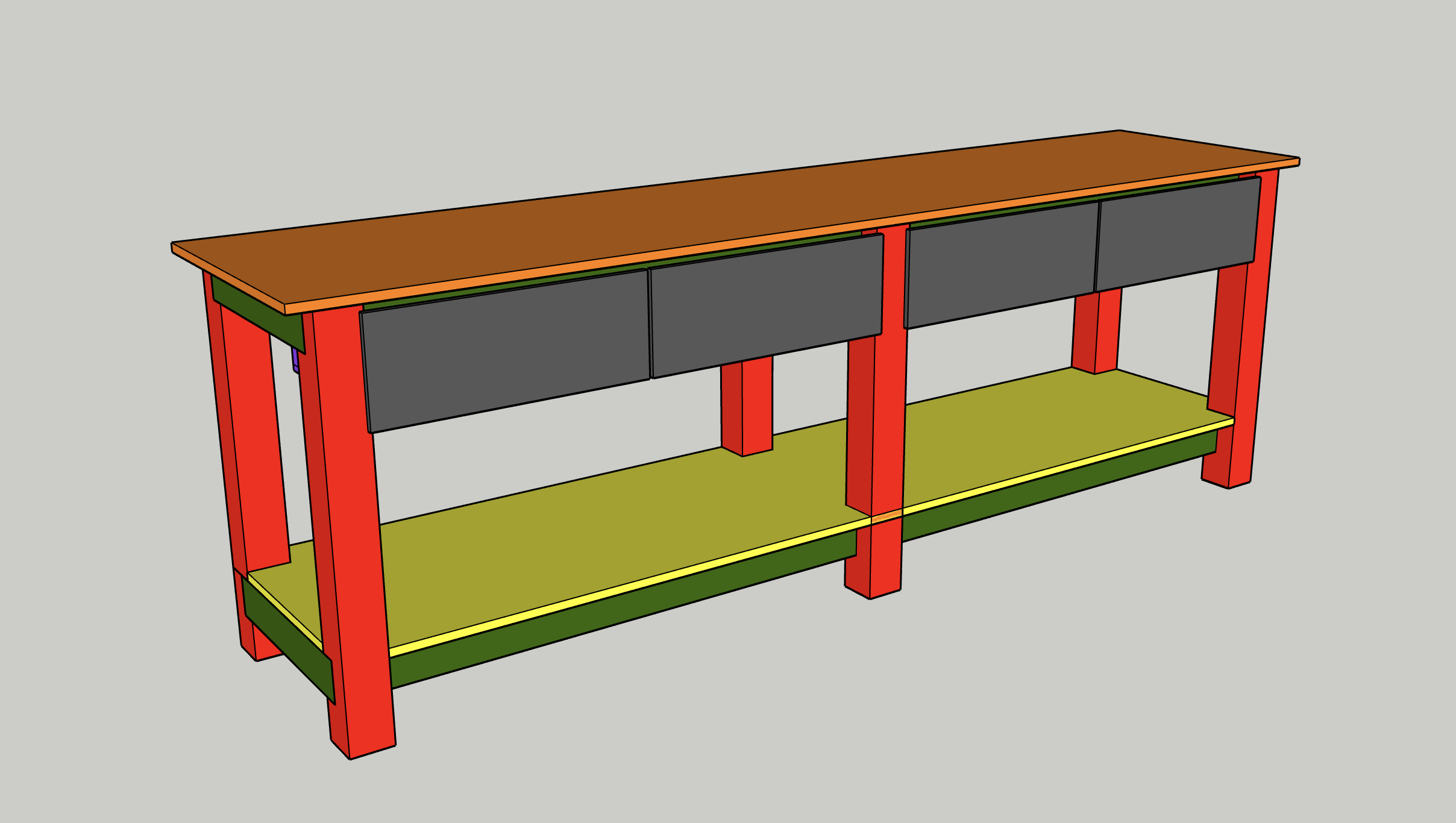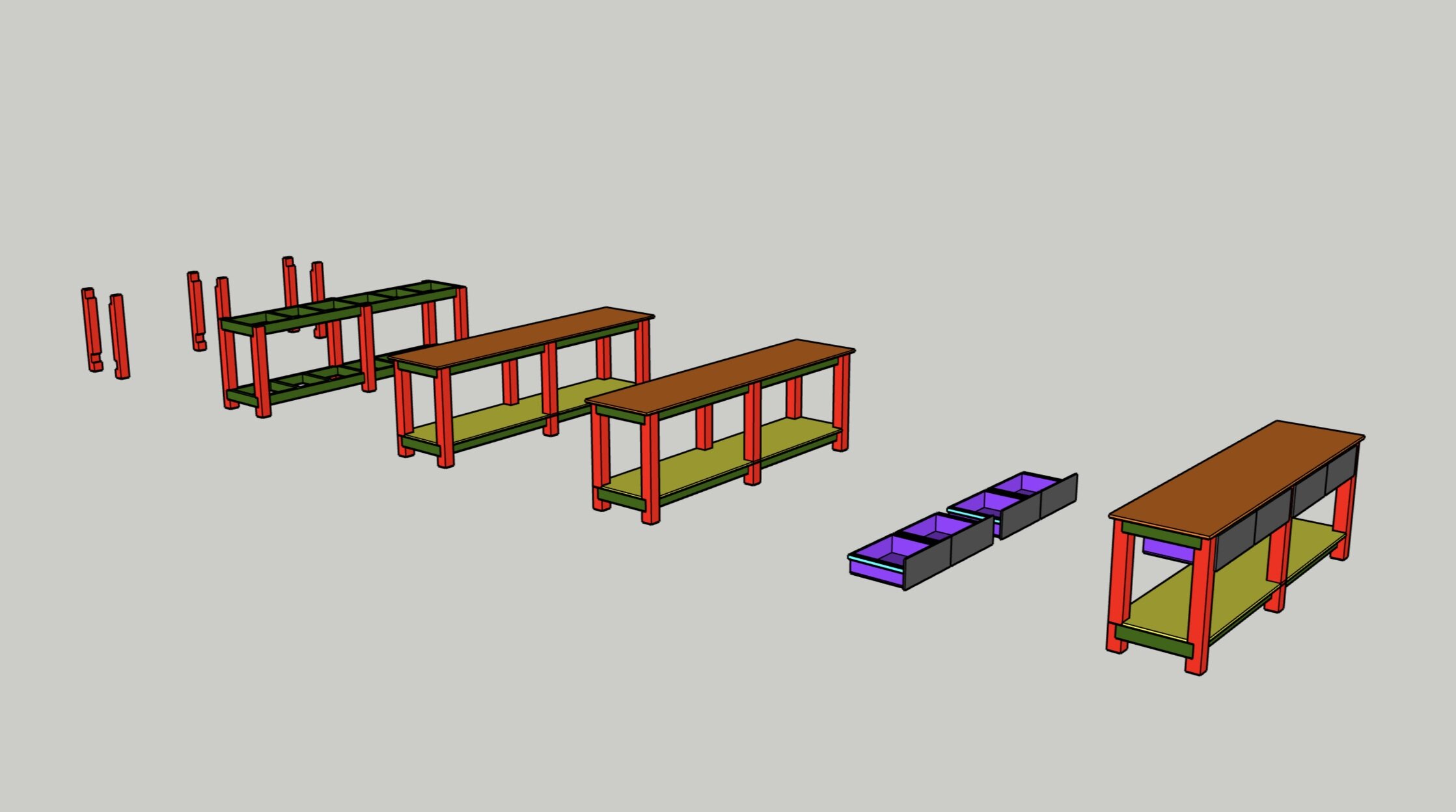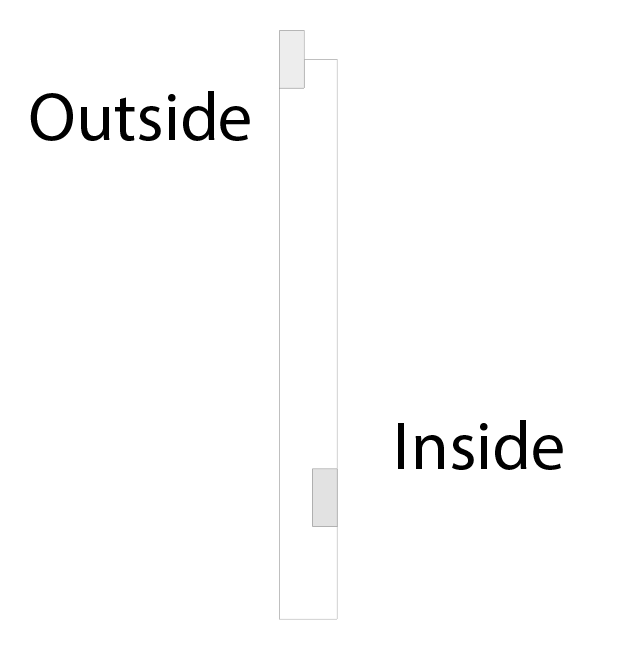After moving into my home a few months ago, my priority from day one was to continue to build out my garage into my dream workshop. Garages will always have their limitations, so I have been consistently trying to best utilize my space before making any bit decisions. This workbench was a long time coming - something big, robust, heavy as all hell, and that gave me storage with a ton of work area surface. Excited to share my build!
Below is the final design for the bench, as well as all the components of the build.
Here is the SketchUp file for purchase if you want to build it!


You can see the sad state that was my "temporary solution". These cabinets weren't bad necessarily, but they were very ineffective for what I needed moving forward.
MATERIALS
2 x 4' x 8' x 3/4" Plywood
2 x 10' x 4" x 4"
6 x 2' x 4' 10'
1 x 5mm x 4' x 4' plywood
TiteBond II Wood Glue: http://amzn.to/2peRFus
2.5" Screws
TOOLS
Sawstop
Contractors 30” Saw: https://amzn.to/2Luh91q
RYOBI
10 in. Sliding Compound Miter Saw: http://amzn.to/2q1klHw
Miter Saw Stand: http://amzn.to/2p1072e
Circular Saw: http://amzn.to/2q1l5wn
Impact Driver: http://amzn.to/2q1l5wn
Cordless Brad Nailer: http://amzn.to/2p1dYFD
KREG
K5 Pocket Hole Jig: http://amzn.to/2qb8S7t
Quick Clamp: http://amzn.to/2riyHU8
My 4 x 4's were 10' long, so I marked out 34" (Pic 1) and ripped to length on my miter saw (Pic 2). My saw is just big enough for this. I repeated that for all six legs (Pic 3).
Pic 1 shows how I plan to cut dados and half lap joints into the legs to accept stretchers.
For bottom supports, I wanted to have my stretchers recessed in the legs. Pics 2-3 show me marking and measuring out the space that I'd later cut away with dados. These are for the Outside Dados.
Pics 4-5 show me cutting those dados on the miter saw using a miter gauge. Note that I do not have the piece sliding up against the fence - that is dangerous. Instead, clamp a piece at the front of your saw where you start, then when you rest your piece up against it, it will be in the proper position. As you move away from it over the blade, your piece will stay in that position against your miter gauge but won't be up against the fence. And I cut them for all six legs (Pic 6).
I then ripped the full dados on each leg for the button stretchers (Pics 7-8). These are Inside Dados
After cutting my dados, I moved to ripping my stretchers to length. They were around 10' long - I clamped them all together and cut them with a circular saw (Pic 1). I then laid out everything to begin assembly (Pic 2).
Three legs per side - I put a single stretcher in the bottom dado (Pic 3) and used a spacer block to line up the piece. I designed this so the stretcher would fill the entire dado, less the width of a 2x4 which would later be filled with an actual 2x4 for cross supports.
I applied glue and used 2.5" wood screws to hold things in place, checking for square in the process (Pics 4-5).
I then repeated that process for the other outside leg, and then lined up the middle stretcher (Pic 6) and attached using glue and screws. Pic 7 shows one final full leg support.
Note - i should have cut my top stretchers 3" longer - you can see they don't go all the way to the edges in Pic 7 - it's not a big deal - actually, that space can be used to put a vice in! Making lemonade...
I cut a bunch of 2 x 4's on the miter saw to specific lengths (in my case I was looking to make my bench about 25" deep on the top) (Pic 1). I then used glue and screws to attached everything together - Pics 2-4 show me doing the top stretchers. Pic 5 shows me attaching the supports at the bottom - you can see here, per my earlier step, why I left the 1.5" gap on the ends, as now I could insert a 2x4 in that gap and bring everything together. Very sturdy!
I also cut middle stretchers for the middle of the bench (Pics 6-7) - I had 7 total stretchers on the top and bottom to provide rigidity and support for my work surface. The middle stretchers that were not on the outsides are just held together with screws.
My dad and I ripped down our sheet of plywood on the table saw (Pic 1). The top sheet was full length, and about 25" wide - this was purposeful as it left about 23" of width on the remainder of the piece to be used for the bottom shelf. Since the bottom stretchers were on the insides of the posts, it made the lower shelf skinnier than the bench to - so again, this was perfect.
I lined up the top surface to the bench and attached it using brad nails (Pics 2-3). I wanted the freedom later on to replace this top with new material if it ever got too dinged up. For the bottom shelf, I needed to measure and notch out places for the 4x4s to go. I did this by measuring the bottom shelf and then cutting out the spaces with a jig saw (Pic 4). And it fell nicely into place after (Pic 5).
Since the bench was between 9 - 10 feet long, I needed additional plywood to finish out the top. I cut down the remainder from a second sheet of plywood (Pic 6) and then attached the top and bottom pieces again using brad nails (Pics 7-8). I needed to notch out the bottom piece like I did the other parts, but that was a lot of the same so I don't show it here.
You're left with a 4' x 6' sheet of 3/4" plywood - this is a ton of extra wood - I ended up making a huge clamp rack out of it - so although it felt like I might be way overbuying for this bench, there is nothing like having a huge amount of scraps to make something else that is very useful!
After the bench was assembled, I cleaned out the space and wiggled the bench into place. It was really heavy. Once I added all my tools to it, I couldn't physically move it.
Perfect!
I decided last minute to add drawers with additional scrap plywood that I salvaged from my parents old TV credenza that they were looking to toss. It was pretty high quality furniture plywood, so it ripped easily on the table saw (Pic 1) and miter saw (Pic 2). The drawers would be 4" tall and were as deep as the bench measured.
I then cut dados on the table saw to accept the drawer bottom. The kerf of the blade makes it so you just need to make two passes on the table saw 1/8" apart - very quick and easy (Pic 3). I then drilled pocket holes for joinery (Pic 4).
I used a sheet of 5mm 4'x4' plywood for the drawer bottoms that I broke down on my table saw (Pic 5). I then assembled everything - first attaching three sides together (Pic 6), then sliding in the drawer bottom between the dados, and then adding the fourth side. And I repeated that for all four drawers (Pic 7).
I didn't want to buy drawer slides - this just felt unecessary and there wasn't really anything for me to mount them too on this bench.
Instead, I cut three pieces - a single 3/4" x 3/4" strip that would attach to the top sides of the drawer, an additional strip of the same size, and a strip that was 1.5" x 3.4", the ladder of which would combine to form an L. The L would be mounted to the bottom of the top shelf, and the strip could then be slide into it. Pic 1 shows this set up but upside down - it was really easy and I hope my explanation is clear!
Pics 2-4 show me making the "L" pieces. I drilled and counter sunk the holes so that when I glued up and screwed together, the screws didn't split the plywood or stick out and hinder the sliding of the drawer. Using little squeeze clamps while attaching screws was very handy.
I then repeated the same process for the strips that would be mounted to the drawers, and mounted them (Pics 5-6). I then could mount the slides to the underside of the drawer (Pic 7), and then slid in all four drawers (Pic 8).
NOTE - make sure your "L" stretchers are long enough to span the underside of the bench - I almost messed this up by cutting them too short!
These drawers were massive - about 2' x 2', and I loved them. I decided last minute to add some false drawer fronts. This would make the piece a bit "prettier" and would also prevent the drawers from sliding any further back than they needed too.
I used left over walnut plywood from Purebond for this step - but you can just as easily use any type of wood for this - hardwoods, different plywoods, whitewoods, etc.
I unfortunately did not have enough material in the right size to make the drawer fronts a continuous grain, but anyways - I ripped down the pieces on the table saw (Pics 1-2) based on the sizes I needed.
I then clamped into place, leveled off, and attached the drawer fronts using some brad nails (Pics 3-5).
I then marked center and drilled pilot holes for some single pine door nobs that I had from left over Ikea furniture back in the day (Pic 6). Then just some screws to attach them (Pic 7).
I didn't film me putting on a finish, but I used some cutting board oil just to bring out the grain - I didn't want to go fancy and I didn't want to spend any more time making this thing! You can see how big and robust this thing is with me next to it, how the drawers look, and how many tools it olds.
I love it!
Thanks for reading - make sure you check out the video in the first step on my YT channel!
See you around!
Zach


























































